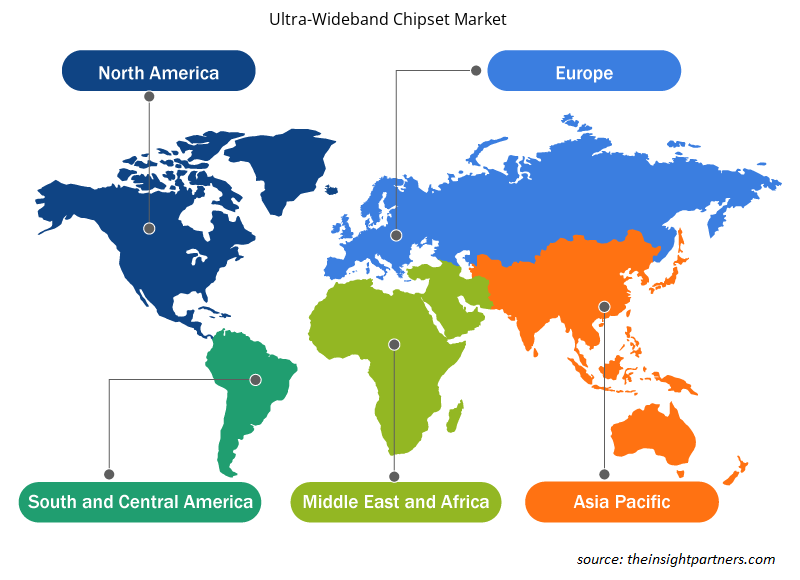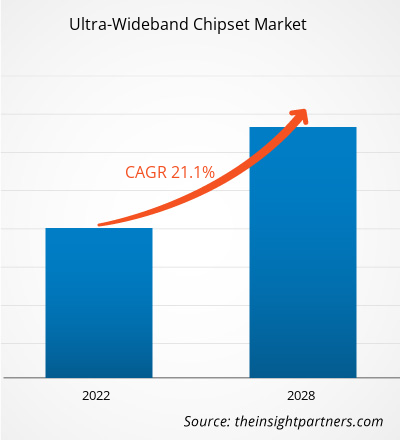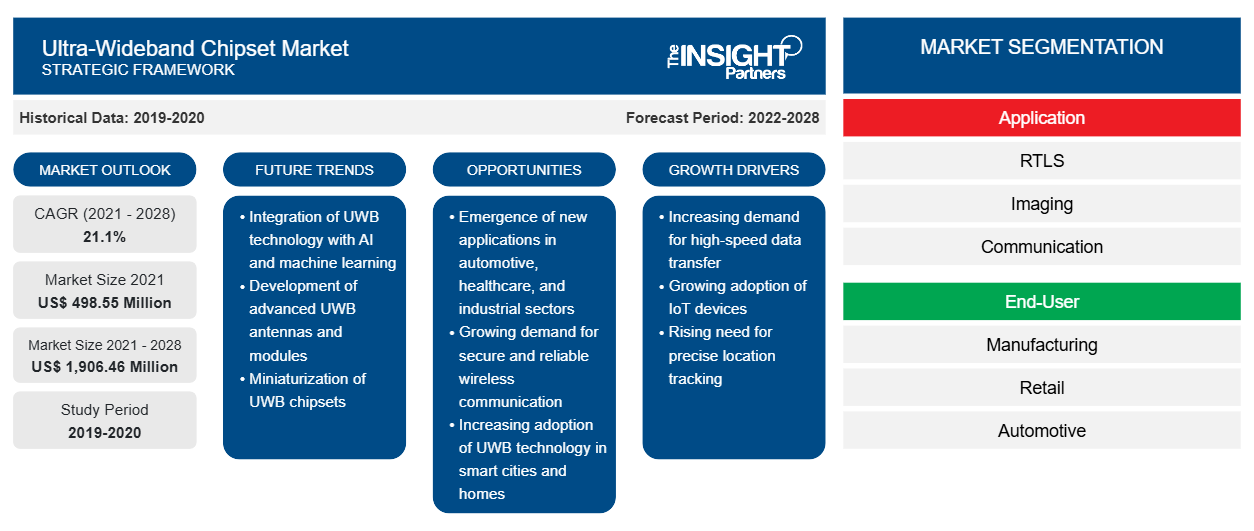Le marché des chipsets ultra-large bande a été évalué à 498,55 millions USD en 2021 et devrait atteindre 1 906,46 millions USD d'ici 2028 ; il devrait croître à un TCAC de 21,1 % de 2021 à 2028.
L'ultra-large bande est l'une des technologies en pleine croissance adoptées dans les systèmes de localisation en temps réel (RTLS) avec un potentiel de croissance considérable en raison de sa plus grande précision dans le suivi des objets. La technologie UWB offre une précision élevée et une large portée ainsi qu'une consommation d'énergie inférieure à celle d'autres technologies RTLS telles que la RFID ; cela a conduit à une pénétration accrue de la technologie UWB dans les applications nécessitant une grande précision. En raison de cette précision supérieure de la technologie UWB, plusieurs utilisateurs finaux de RTLS sont passés de la RFID et du Wi-Fi à la technologie UWB pour améliorer l'efficacité du produit. De plus, les solutions RTLS intégrées à l'UWB offrent divers avantages aux applications RTLS, stimulant ainsi le marché des chipsets à bande ultra-large
Personnalisez ce rapport en fonction de vos besoins
Vous bénéficierez d'une personnalisation gratuite de n'importe quel rapport, y compris de certaines parties de ce rapport, d'une analyse au niveau des pays, d'un pack de données Excel, ainsi que de superbes offres et réductions pour les start-ups et les universités.
- Obtenez les principales tendances clés du marché de ce rapport.Cet échantillon GRATUIT comprendra une analyse de données, allant des tendances du marché aux estimations et prévisions.
Impact de la pandémie de COVID-19 sur la taille du marché des chipsets ultra-large bande en Asie-Pacifique
En raison de la pandémie de COVID-19, plusieurs régions ont beaucoup souffert, en particulier la région Asie-Pacifique. Les secteurs manufacturiers du monde entier ont connu une faible production et une chaîne d'approvisionnement plus faible. En outre, la pénurie de main-d'œuvre a également affecté l'industrie manufacturière. Les installations de production de systèmes basés sur UWB ont également été fermées ou incapables de produire une capacité totale, ce qui a eu un impact négatif sur les revenus des entreprises de 2020 à mi-2021 et a entraîné un ralentissement de la croissance à court terme. Cependant, avec l'utilisation croissante de la technologie de surveillance à distance, les outils de gestion de logiciels pourraient conduire à une adoption plus élevée pendant la période post-COVID. Ainsi, l'impact global de COVID-19 sur le marché des chipsets ultra-large bande à travers le monde est faible à modéré.
Perspectives du marché – Marché des chipsets à bande ultra large
L'adoption croissante de la technologie UWB dans le suivi des appareils personnels et grand public propulse la croissance du marché des chipsets ultra-large bande
L'UWB améliore considérablement l'expérience client des produits de divertissement à domicile tels que les ordinateurs portables, la télévision et l'audio. Cela a conduit à une adoption croissante de la technologie UWB et a finalement stimulé la croissance du marché des chipsets à bande ultra-large. Elle est également utilisée pour suivre les objets personnels. Par exemple, la puce Apple U1 pour la perception spatiale est intégrée aux iPhones 11, 12 et 13. De plus, après Apple, divers fabricants de smartphones ont intégré la technologie UWB dans leurs produits, contribuant à la croissance du marché des chipsets à bande ultra-large. De plus, en avril 2021, Apple a sorti AirTag avec la technologie UWB, après quoi Samsung a officiellement lancé son tracker Galaxy SmartTag+ comprenant UWB. Ainsi, l'augmentation du taux d'adoption contribue à la croissance du marché des chipsets à bande ultra-large. significantly enhances the consumer experience of home entertainment products such as laptops, TV, and audio. This has led to increasing UWB technology adoption and eventually boosts the ultra-wideband chipset market growth. It is also being used to track the personal item. For example, the Apple U1 chip for spatial awareness is integrated into iPhones 11, 12, and 13. In addition, after Apple, various smartphone manufacturers have integrated UWB technology in their products, contributing to the growth of the ultra-wideband chipset market. Moreover, in April 2021, Apple released AirTag with UWB technology, post which Samsung officially launched its Galaxy SmartTag+ tracker comprising UWB. Thus, the surge in adoption rate contributes to the growth of the ultra-wideband chipset market.
Informations basées sur les applications
En fonction de l'offre, le marché des chipsets à bande ultra large est segmenté en RTLS, imagerie et communication. Le segment des communications a dominé le marché en 2021. La communication sans fil UWB transmet des données considérables sur un large spectre de fréquences allant de 3,1 à 10,6 GHz. Elle comprend des applications de télémétrie, d'authentification, d'USB sans fil et de transfert de données. En outre, la demande de systèmes de communication sans fil à large bande a considérablement augmenté, en raison d'applications émergentes telles que la mise en réseau ad hoc mobile et la collecte de données via un réseau de capteurs sans fil , ce qui stimule la demande de taille de marché des chipsets à bande ultra large.ultra-wideband chipset market is segmented into RTLS, imaging, and communication. The communication segment led the market in 2021. UWB wireless communication transmits considerable data over a broad frequency spectrum ranging from 3.1 to 10.6 GHz. It includes ranging, authentication, wireless USB, and data transfer applications. Furthermore, the demand for wireless wideband communications systems has increased significantly, owing to emerging applications such as mobile ad-hoc networking and data collection through a ultra-wideband chipset market size.
Le marché des chipsets à bande ultra large est segmenté en fonction de l'application, de l'utilisateur final et de la géographie. En fonction du type, le marché des chipsets à bande ultra large est classé en systèmes de mesure d'imagerie et systèmes de mesure sans imagerie. En fonction de l'utilisateur final, le marché des chipsets à bande ultra large est segmenté en fabrication, vente au détail, automobile, soins de santé et électronique grand public. Géographiquement, le marché des chipsets à bande ultra large est segmenté en Amérique du Nord, Europe, Asie-Pacifique (APAC) et reste du monde. ALEREON, INC. ; Apple Inc. ; Bespoon SAS ; Decawave Limited ; TAIYO YUDEN CO., LTD. ; Taoglas ; Johanson Technology, Inc. ; NOVELDA ; NXP Semiconductors NV ; et Pulse-Link, inc. font partie des principaux acteurs présentés lors de l'étude de marché des chipsets à bande ultra large.ultra-wideband chipset market is segmented based on application, end user, and geography. Based on type, the ultra-wideband chipset market is categorized into imaging measurement systems and non-imaging measuring systems. Based on end user, the ultra-wideband chipset market is segmented into manufacturing, retail, automotive, healthcare, and consumer electronics. Geographically, the ultra-wideband chipset market is segmented into North America, Europe, Asia Pacific (APAC), and the Rest of World. ALEREON, INC.; Apple Inc.; Bespoon SAS; Decawave Limited; TAIYO YUDEN CO., LTD.; Taoglas; Johanson Technology, Inc.; NOVELDA; NXP Semiconductors N.V.; and Pulse-Link, inc. are among the key players profiled during the ultra-wideband chipset market study.
Aperçu régional du marché des chipsets à bande ultra large Chipset Market Regional Insights
Les tendances et facteurs régionaux influençant le marché des chipsets à bande ultra-large tout au long de la période de prévision ont été expliqués en détail par les analystes d’Insight Partners. Cette section traite également des segments et de la géographie du marché des chipsets à bande ultra-large en Amérique du Nord, en Europe, en Asie-Pacifique, au Moyen-Orient et en Afrique, ainsi qu’en Amérique du Sud et en Amérique centrale.Ultra-Wideband Chipset Market throughout the forecast period have been thoroughly explained by the analysts at Insight Partners. This section also discusses Ultra-Wideband Chipset Market segments and geography across North America, Europe, Asia Pacific, Middle East and Africa, and South and Central America.

- Obtenez les données régionales spécifiques au marché des chipsets à bande ultra largeUltra-Wideband Chipset Market
Portée du rapport sur le marché des chipsets à bande ultra large
| Attribut de rapport | Détails |
|---|---|
| Taille du marché en 2021 | 498,55 millions de dollars américains |
| Taille du marché d'ici 2028 | 1 906,46 millions de dollars américains |
| Taux de croissance annuel moyen mondial (2021-2028) | 21,1% |
| Données historiques | 2019-2020 |
| Période de prévision | 2022-2028 |
| Segments couverts | Par application
|
| Régions et pays couverts | Amérique du Nord
|
| Leaders du marché et profils d'entreprises clés |
|
Densité des acteurs du marché des chipsets à bande ultra large : comprendre son impact sur la dynamique commerciale
Le marché des chipsets à bande ultra-large connaît une croissance rapide, tirée par la demande croissante des utilisateurs finaux en raison de facteurs tels que l'évolution des préférences des consommateurs, les avancées technologiques et une plus grande sensibilisation aux avantages du produit. À mesure que la demande augmente, les entreprises élargissent leurs offres, innovent pour répondre aux besoins des consommateurs et capitalisent sur les tendances émergentes, ce qui alimente davantage la croissance du marché.
La densité des acteurs du marché fait référence à la répartition des entreprises ou des sociétés opérant sur un marché ou un secteur particulier. Elle indique le nombre de concurrents (acteurs du marché) présents sur un marché donné par rapport à sa taille ou à sa valeur marchande totale.
Les principales entreprises opérant sur le marché des chipsets à bande ultra-large sont :
- ALEREON, INC.
- Apple Inc.
- Bespoon SAS
- Decawave Limitée
- TAIYO YUDEN CO., LTD.
Avis de non-responsabilité : les sociétés répertoriées ci-dessus ne sont pas classées dans un ordre particulier.

- Obtenez un aperçu des principaux acteurs du marché des chipsets à bande ultra large
Les acteurs opérant sur le marché des chipsets ultra-large bande se concentrent principalement sur le développement de produits avancés et efficaces.
- En 2021, Apple Inc. a lancé AirTag avec le chipset U1 UWB conçu pour suivre les objets à l'aide de l'iPhone.
- En 2020, Samsung a lancé son nouveau smartphone baptisé Samsung Galaxy Note20 Ultra, alimenté par le chipset ultra-large bande de NXP Semiconductors.
- Analyse historique (2 ans), année de base, prévision (7 ans) avec TCAC
- Analyse PEST et SWOT
- Taille du marché Valeur / Volume - Mondial, Régional, Pays
- Industrie et paysage concurrentiel
- Ensemble de données Excel
Rapports récents
Rapports connexes
Témoignages
Raison d'acheter
- Prise de décision éclairée
- Compréhension de la dynamique du marché
- Analyse concurrentielle
- Connaissances clients
- Prévisions de marché
- Atténuation des risques
- Planification stratégique
- Justification des investissements
- Identification des marchés émergents
- Amélioration des stratégies marketing
- Amélioration de l'efficacité opérationnelle
- Alignement sur les tendances réglementaires





















 Obtenez un échantillon gratuit pour - Marché des chipsets ultra-large bande
Obtenez un échantillon gratuit pour - Marché des chipsets ultra-large bande